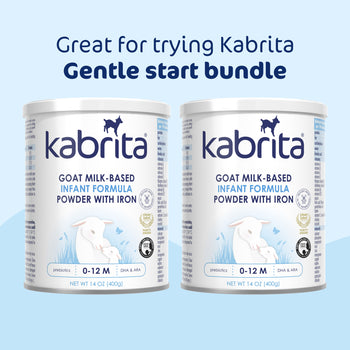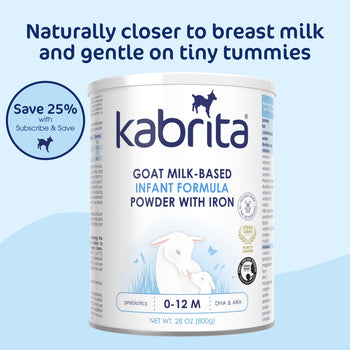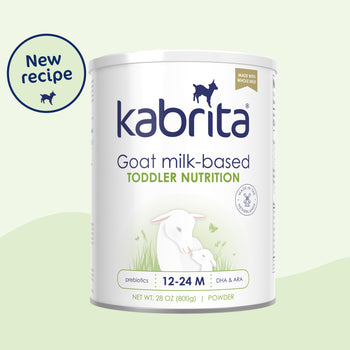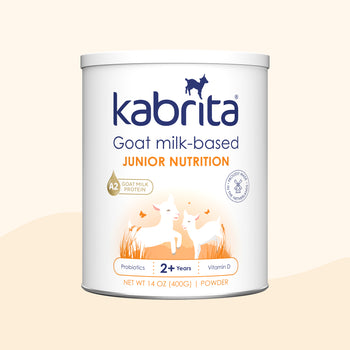Goat Milk Formula vs Cow Milk Formula: Which is Better for Your Baby?
By Kelsey Kunik, RDN
Registered Dietitian Nutritionist
As parents, we have an unending list of decisions to make for our family, especially when there’s a new baby in the picture. If you rely on formula to feed your baby, the most common option in the US has always been cow milk formula, but another type of formula has been making an appearance on store shelves over the past decade— that’s goat milk formula. “While there is no exact substitute for human breastmilk, the milk of both cows and goats has been used as a base to create infant formula for over 200 years,” says Ari Brown, MD, FAAP. Goat milk formula has been a staple in infant nutrition around the world for decades, and recently, trusted brands like Kabrita have made it more popular than ever in the US with their FDA-accepted European formula.
So which one should you choose? When comparing goat milk formula vs cow milk formula, it’s important to look at the similarities and differences and decide, along with your pediatrician, which option is best for your baby. Keep reading for a side-by-side comparison to make a confident and informed decision.
Table of Contents:
What Goat Milk Formula and Cow Milk Formula Have in Common
Whichever you choose, know that goat milk formula and cow milk formula that meet FDA requirements are designed to meet the nutritional needs of your baby.1
Goat Formula vs Cow Formula: Common Ingredients to Support Infant Nutrition
While each formula has unique characteristics and benefits for your baby, there are plenty of similarities between the two. Here are some ways goat milk formula and cow milk formula are similar.
Both are fortified with essential vitamins and minerals
By themselves, goat's milk and cow’s milk are not suitable for infant nutrition. Infant formula made from each of these kinds of milk is fortified with vitamins, minerals, and other nutrients to meet your baby’s nutrition needs and mimic the nutritional quality of breastmilk. Kabrita goat milk formula is fortified with 25 vitamins and minerals, including folic acid, iron, DHA, and ARA, to support healthy growth and development.
Many include healthy fats for brain development
The FDA requires that between 30 and 54 percent of calories come from fat and that at least 300 milligrams of linoleic acid (omega-6 fatty acids) are found in every 100 kcal of formula, whether it’s cow or goat milk formula.2 While the FDA doesn’t require the addition of DHA, an omega-3 fatty acid that’s connected to potential benefits in visual acuity and cognitive health in infants, the European Union requires a minimum level of 20 milligrams per 100 kcal of formula.3 So while it’s not required, many cow milk and goat milk formulas are fortified with this essential fatty acid.
Both provide lactose as the primary source of energy
Lactose is naturally the main carbohydrate found in all mammalian milk, whether it be human, cow's, or goat's milk. Whether it’s cow milk formula or goat milk formula, lactose is used to provide energy to your baby. Alternatively, some “sensitive” formulas may use corn syrup as the main carbohydrate source and can be used if a baby has a severe lactose intolerance.
Both contain proteins to help your baby grow
Both cow milk and goat milk formula sold in the US must have between 1.8 and 4.5 grams of protein for every 100 kcal of formula.2 They both include various types and ratios of whey and casein proteins, two proteins found in breastmilk as well.
What’s the difference between cow and goat milk formula?
While both cow and goat milk formulas include the nutrients your baby needs, there are some key differences between the two that may impact how your baby digests and absorbs nutrients.
Key Nutritional Differences Between Goat Milk Formula and Cow Formula
These differences involve the protein structure, fat content, and how gentle and supportive each formula is on your baby’s digestive system. Here are some of the major differences between goat milk formula and cow milk formula.
They have different protein structures
Goat and cow milk both include whey and casein proteins, but the difference in structure makes goat milk easier for many babies to digest.
Goat milk formula contains Alpha S2 Casein proteins which are also present in human breastmilk, and help form softer curds in your baby's tummy. Cow’s milk is made up of mostly Alpha S1 Casein proteins, which research has found is more likely to cause digestive inflammation and symptoms.4, 5
They have different amounts of lactose
While both formulas and breastmilk include lactose, goat milk is naturally lower in lactose than cow milk. However, Kabrita adds lactose to their goat milk formula for optimal carbohydrates and energy for your baby. While many parents misdiagnose their baby as lactose intolerant due to digestive upset or discomfort from cow milk formula, the American Academy of Pediatrics says true lactose intolerance is rare in babies under two years old.6
Natural difference in prebiotics
“Beyond the gentler, more easily digestible proteins, goat milk naturally contains more volume and diversity of key prebiotics, called oligosaccharides (or GOS), compared to cow’s milk,” says Dr. Brown, “This bioactive ingredient helps with both digestion and immune function, and it is a key nutrient found in human milk.” Goat milk formula naturally includes this gut-benefiting compound, but since the levels found in goat milk are still much lower than human breastmilk, Kabrita adds additional oligosaccharides to better mimic the prebiotic benefit your baby would get from breastmilk.7
Their fats are different in size and structure
The fat composition of goat milk is closer to that of breastmilk in terms of structure and the types of fatty acids found. Goat milk contains higher amounts of the medium-chain fatty acids C6:0, C8:0, and C10:0, which are more readily released and absorbed than the types of fat predominantly found in cow milk.8 This may help your baby’s tummy more easily digest goat milk formula with less discomfort.
Formula Comparison Chart for Goat Milk vs Cow Milk Formula: The Final Verdict
As you can see, goat milk and cow milk formula share many similarities that make them both great options for feeding your little one, but the differences help goat milk stand out, especially for babies with sensitive digestive systems.
Goat vs Cow Formula Comparison Chart

The Rise in Popularity of Goat Milk Formula
Goat milk formula has been a popular option for feeding babies around the world for two hundred years but is just starting to gain popularity in the United States. Recent research has found that the differences in fat molecules and protein structures make goat milk formula an option that’s easier on a baby’s digestive system than cow milk formula. As parents are looking for solutions to help reduce gas, constipation, discomfort, and fussiness, many are now making the switch or starting their babies out on goat milk formula.
Goat Milk Formula vs Cow Milk Formula FAQs
Is goat milk formula better than cow milk formula?
For some babies, goat milk formula may be a better choice than cow milk formula as it may be easier to digest and better tolerated by those with sensitive tummies.
Can I mix goat milk formula with cow milk formula?
It’s best to stick to one type of formula and slowly transition them from one to another if you’re thinking about switching from cow to goat formula. That said, do not mix any two formulas together. Make sure to always follow the manufacturer’s instructions on how to mix any formula.
What is the healthiest formula for babies?
All infant formulas that meet FDA requirements are nutritionally complete to help your baby grow and thrive during the first year of life. Some formulas have added nutrients above and beyond what the FDA requires and are more aligned with European-manufactured baby formulas that have added DHA to mimic what’s found in breastmilk and support cognitive development.
Goat milk formula vs. cow milk formula: which is better?
The answer to the question “is goat formula better than cow formula?” often depends on personal preference and your baby’s unique needs. “Both cow and goat milk-based commercial infant formulas meet all the nutritional requirements for human babies,” says Dr. Brown, “The reason why many families worldwide opt for a goat milk-based infant formula is that it is easier for babies to digest.”
Should I switch my baby to goats milk formula?
If your baby has a difficult time digesting traditional cow milk formula or you’re considering switching your baby from breastmilk to formula or combo feeding, talk to your pediatrician about switching your baby to goat’s milk formula as it’s most similar, by nature, to breastmilk and often more gentle for a baby’s tummy.
Is goat formula easier to digest?
Yes, goat milk formula is easier to digest than cow milk formula thanks to the higher proportion of Alpha S2 Casein proteins compared to the Alpha S1 Casein proteins in cow’s milk, which take longer to digest.4,5
At the end of the day, choosing between goat milk formula and cow milk formula comes down to what works best for your family and baby. Both options have all the nutrients your little one needs to grow, with goat milk formula offering the added benefit of being easier to digest.
There’s no one-size-fits-all solution for feeding your baby, and they can absolutely thrive on either formula. If you’re unsure of which option to choose, always consult with your pediatrician to find the right fit for your family.
References
- Program, H. F. (2024, August 14). Infant Formula. U.S. Food And Drug Administration. https://www.fda.gov/food/resources-you-food/infant-formula
- CFR - Code of Federal Regulations Title 21. (n.d.). https://www.accessdata.fda.gov/scripts/cdrh/cfdocs/cfcfr/cfrsearch.cfm?fr=107.100
- Strzalkowski, A., Black, G., & Young, B. E. (2023). Iron and DHA in Infant Formula Purchased in the US Fails to Meet European Nutrition Requirements. Nutrients, 15(8), 1812. https://pmc.ncbi.nlm.nih.gov/articles/PMC10143847/
- Jianqin, S., Leiming, X., Lu, X., Yelland, G. W., Ni, J., & Clarke, A. J. (2016). Effects of milk containing only A2 beta casein versus milk containing both A1 and A2 beta casein proteins on gastrointestinal physiology, symptoms of discomfort, and cognitive behavior of people with self-reported intolerance to traditional cows' milk. Nutrition journal, 15, 35. https://pubmed.ncbi.nlm.nih.gov/27039383/
- Ul Haq, M. R., Kapila, R., Sharma, R., Saliganti, V., & Kapila, S. (2014). Comparative evaluation of cow β-casein variants (A1/A2) consumption on Th2-mediated inflammatory response in mouse gut. European journal of nutrition, 53(4), 1039–1049. https://pubmed.ncbi.nlm.nih.gov/24166511/
- Heyman, M. B. (2006). Lactose intolerance in infants, children, and adolescents. PEDIATRICS, 118(3), 1279–1286. https://publications.aap.org/pediatrics/article/118/3/1279/69390/Lactose-Intolerance-in-Infants-Children-and
- van Leeuwen, S. S., Te Poele, E. M., Chatziioannou, A. C., Benjamins, E., Haandrikman, A., & Dijkhuizen, L. (2020). Goat Milk Oligosaccharides: Their Diversity, Quantity, and Functional Properties in Comparison to Human Milk Oligosaccharides. Journal of agricultural and food chemistry, 68(47), 13469–13485.https://pmc.ncbi.nlm.nih.gov/articles/PMC7705968/
- Gallier, S., Tolenaars, L., & Prosser, C. (2020). Whole Goat Milk as a Source of Fat and Milk Fat Globule Membrane in Infant Formula. Nutrients, 12(11), 3486. https://pmc.ncbi.nlm.nih.gov/articles/PMC7696746/



